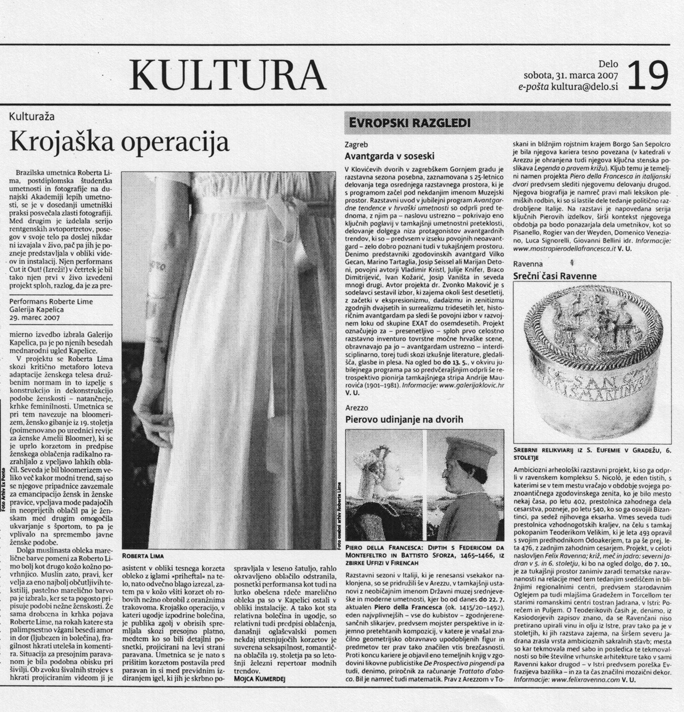
Brazilian artist, Roberta Lima, a postgraduate student of art and photography at the Academy of Fine Arts in Vienna, began her artistic career with her interest mainly in photography. Amongst other work, she made a series of x-ray self portraits and up until now, she had not yet presented a live performance before, but showed video installations. Her performance "Cut it out!", performed on Thursday, was her first live realized performance ever. Her reason for choosing Kapelica for her premiere was, in her own words, “because of the international reputation of the gallery”.
Roberta Lima deals, through critical metaphors, with the adaptation of the female body to the norms of society and she does it by constructing and deconstructing the image of femininity, of fragile femininity, to be exact. The artist refers to bloomerism, a female movement in late 19th century (named after the editor of a magazine for women, Amelia Bloomer) that stood up against corsets and radically relaxed the female dresscode of that time, with the design of lighter, less restrictive clothing.
Of course, bloomerism was much more than just a fashion trend, because its members were fighting for emancipation and women’s rights, introducing the fashion of long flowing dresses and loose clothes, which enabled women to take part in sports along with other activities, which influenced the change of the female image in public.
A long, apricot-coloured, muslin dress represents to Roberta Lima more an outer layer of the skin than a "second skin". She chose this particular material because it was one of the most delicate fabrics and the colour was chosen since it is often attributed to the notion of tender femininity. Roberta Lima, whose hands are scarred with words “amor” and “dor” (love and pain), which embody and comment on fragility with her tiny and fragile appearance and body. The scene behind the transparent projection screen was similar to a visit to the tailor’s. With the sound of sewing machines and video projections running in the background, the tailor [piercer] adjusted the dress, attaching it to her body with needles to make a sort of corset. He then cut out the unused fabric and tightened the corset with orange ribbons. The audience observed through a transparent screen as the tailor [piercer] worked and a scene was shown in which comfort is overthrown by pain, while detailed closeups were projected on the left side of the screen. The artist then appeared in front of the projection screen and carefully removed the needles from of her body, placing them into a wooden box. She took off the slightly bloodied dress and placed it on a mannequin and left it with the video projections running in the gallery as an installation.
As much as comfort and pain are relative, dresscode is relative and nowadays corsets commercially represent sovereign sex appeal and romantic dresses from 19th century are this year's iron repertoire of fashion trends.